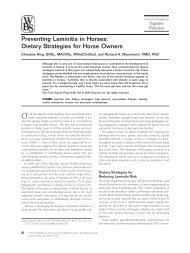Nutritional Secondary Hyperparathyroidism in the Horse
Nutritional Secondary Hyperparathyroidism in the Horse
Nutritional Secondary Hyperparathyroidism in the Horse
Create successful ePaper yourself
Turn your PDF publications into a flip-book with our unique Google optimized e-Paper software.
68 Expcrimcntal <strong>Nutritional</strong> <strong>Secondary</strong> I-Iypcrparathyroidism <strong>in</strong> <strong>the</strong> tIorse . . .<br />
The resorption from VOLKMANN’S canals was liliewise very <strong>in</strong>conspicuous<br />
<strong>in</strong> <strong>the</strong> beg<strong>in</strong>n<strong>in</strong>g. In more advanced stages <strong>the</strong> widen<strong>in</strong>g<br />
of <strong>the</strong> canal could be impressive (Figs. 33,34 and 37). As <strong>the</strong> resorption<br />
from VOLKMANN’S canals proceeded, <strong>the</strong> disruption of lamellae of<br />
HAVERSIAN systems became very prom<strong>in</strong>ent (Figs. 34 and 36). Osteoclastic<br />
resorption of <strong>in</strong>terstitial lamellae occurred, it appeared, only as a<br />
result of lateral expansion of resorptive processes orig<strong>in</strong>at<strong>in</strong>g <strong>in</strong><br />
HAVERSIAN and VOLKMANN’S canals or subperiosteallg (Figs. 34, 36,<br />
38, and 40).<br />
Longitud<strong>in</strong>al sections of compact bone showed that <strong>the</strong> resorption<br />
was very irregular. The width of <strong>the</strong> HAVERSIAN canals varied with<strong>in</strong> a<br />
wide range, and localized encroachment upon adjacent osteons and<br />
<strong>in</strong>terstitial lamellae was frequently encountered.<br />
The outer circumferential lamellae of compact bone were also<br />
sites of resorption. The normal structure (Fig. 39) was never present <strong>in</strong><br />
NSH horses, and <strong>in</strong> most sections <strong>the</strong>re were hardly any remnants of<br />
such lamellae (Fig. 40). Resorption usually expanded <strong>in</strong>to adjacent<br />
osteons and <strong>in</strong>terstitial lamellae (Fig. 40). In o<strong>the</strong>r <strong>in</strong>stances a haphazard<br />
resorption was go<strong>in</strong>g on, and numerous lacunae filled with osteoclasts<br />
were <strong>the</strong>n observed. The resorption was often found to be very much<br />
accentuated locally with large excavations <strong>in</strong>to <strong>the</strong> compact bone and<br />
loss of <strong>the</strong> osseus support of <strong>the</strong> periosteum (Fig. 38).<br />
The morphology of <strong>the</strong> osteoclasts varied. Actively erod<strong>in</strong>g<br />
osteoclasts were usually present <strong>in</strong> HOWSHIP’S lacunae (Figs. 29, 33,<br />
35, 38) or flattened along trabecular (Fig. 29). Their shape varied<br />
accord<strong>in</strong>gly ; <strong>in</strong> <strong>the</strong> former case <strong>the</strong>y were irregularly rounded, <strong>in</strong> <strong>the</strong><br />
latter elongated. The nuclei were relatively large and diffusely scattered<br />
throughout <strong>the</strong> cells. In areas where m<strong>in</strong>eralized bone was no longer<br />
available for resorption, <strong>the</strong> nuclei of <strong>the</strong> osteoclasts were pyltnotic and<br />
retracted centrally or toward one end of <strong>the</strong> cell (Fig. 30). Inactive<br />
osteoclasts trapped <strong>in</strong> fibrous tissue sometimes showed vacuolization<br />
of <strong>the</strong> cytoplasm. In rare <strong>in</strong>stances a phagocytized erythrocyte was<br />
seen <strong>in</strong> osteoclasts <strong>in</strong> hemorrhage areas <strong>in</strong> loose connective tissue.<br />
Fibrosis. The fibrous tissue replac<strong>in</strong>g <strong>the</strong> resorbed bone varied<br />
considerably <strong>in</strong> t<strong>in</strong>ctorial properties <strong>in</strong> different areas. In <strong>the</strong> jawbones<br />
it was ra<strong>the</strong>r well collagenized with a deep-red sta<strong>in</strong><strong>in</strong>g reaction with<br />
van Gieson. Differences <strong>in</strong> collagenization of <strong>the</strong> fibrous tissue did<br />
occur, however, <strong>in</strong> areas of long-stand<strong>in</strong>g resorption. The fibrous<br />
tissue replac<strong>in</strong>g <strong>the</strong> resorbed outer circumferential lamellae was usually<br />
well collagenized (Fig. 37), but <strong>the</strong> birefr<strong>in</strong>gent material (Fig. 40)<br />
Downloaded from<br />
vet.sagepub.com by guest on April 14, 2010



